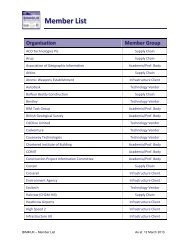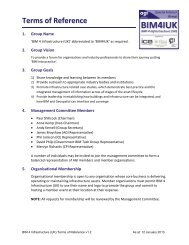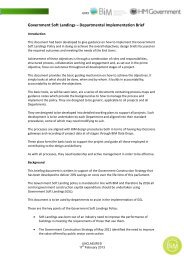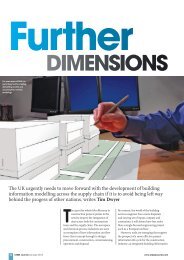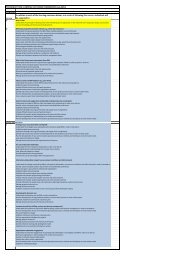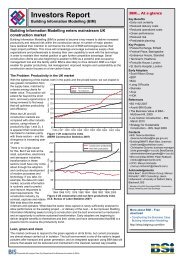BIM Task Group Newsletter 21st Edition
BIM Task Group Newsletter 21st Edition
BIM Task Group Newsletter 21st Edition
You also want an ePaper? Increase the reach of your titles
YUMPU automatically turns print PDFs into web optimized ePapers that Google loves.
www.bimtaskgroup.org<br />
<strong>Newsletter</strong>, <strong>21st</strong> edition | Week ending 9th June 2013<br />
Each table has groups of similar information and follows a hierarchy that expands with increasing<br />
levels of granulation from a two digit code to six digits. For example, in the Administrative and<br />
Commercial group of the entities table Commercial Administrative Buildings are classified as 25-50<br />
with small single office buildings having a lower level classification of 25-50-70. This principle of<br />
increasing granulation applies to all tables.<br />
Activities<br />
Using the tables<br />
Complexes<br />
Entities<br />
Activities Spaces Elements<br />
Systems<br />
Products<br />
There are no hard and fast rules about what is right, so choosing the appropriate table is subjective.<br />
The following are all possibilities for classifying a prison leaving the choice of the most appropriate to<br />
the users but with some consensus sought across the project team.<br />
Co_25_85 Detention complexes<br />
Co_25_85_10 International detention co<br />
plexes<br />
Co_25_85_30 National detention complexes<br />
Co_25_85_50 Regional detention complexes<br />
Co_25_85_70 Local detention complexes<br />
Ac_25_85 Detention activities<br />
Ac_25_85_15 Communal inmate day activities<br />
Ac_25_85_22 Detaining<br />
Ac_25_85_28 Exercising<br />
Ac_25_85_35 Guarding detainees<br />
Ac_25_85_38 Holding<br />
Ac_25_85_59 Open secure visiting<br />
Ac_25_85_66 Private secure visiting<br />
Ac_25_85_95 Vehicle impounding<br />
En_25_85 Detention entities<br />
En_25_85_10 International detention builings<br />
En_25_85_12 International detention<br />
grounds<br />
En_25_85_30 National detention buildings<br />
En_25_85_32 National detention grounds<br />
En_25_85_50 Regional detention buildings<br />
En_25_85_52 Regional detention grounds<br />
En_25_85_70 Local detention buildings<br />
En_25_85_72 Local detention grounds<br />
Sp_25_85 Detention spaces<br />
Sp_25_85_15 Communal inmate dayrooms<br />
Sp_25_85_22 Detention cells<br />
Sp_25_85_28 Exercise yards<br />
Sp_25_85_35 Guard stations<br />
Sp_25_85_38 Holding cells<br />
Sp_25_85_59 Open secure visiting rooms<br />
Sp_25_85_66 Private secure visiting rooms<br />
Sp_25_85_95 Vehicle impound yards<br />
Terminology is another issue, so that words<br />
that we use and understand among ourselves<br />
may not be as clear to others. The language<br />
in classification therefore has to be generic<br />
but project specific information can use more<br />
familiar language.<br />
For example, a prison is described generically<br />
as a Detention complex or a Detention Activity.<br />
Although the classification uses a generic<br />
term, the project specific term can still be<br />
Holloway Prison and the description can either<br />
be of a complex or an activity – both are valid<br />
but a client may have a preference for which is<br />
most appropriate.<br />
Another example is that ‘station’ can be used<br />
to describe a place for catching a train or bus,<br />
but it is also used to describe a ‘fire station’ and<br />
a ‘work station’. So the classification has to be<br />
generic so that it is clear what is being coded.<br />
A station is an embarkation and disembarkation<br />
complex generically but will be known as<br />
a station as far as the project is concerned.<br />
23




